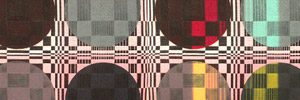Maggie Orth’s electronic textiles

Last Friday, I had the chance to attend a talk at the Stanford D-School. As part of the Liu Memorial Lecture Series in Design, Maggie Orth made a presentation on her work with electronic textiles. Maggie, who has a PhD from MIT’s Media Lab, founded her company International Fashion Machines in 2001 to explore the intersection of electronics and fabrics.
She is currently working on a number of interesting projects. On the artsy side, her electric plaid textile panels use conductive weaves to change the color of thermo-chromic inks. They are quite pretty and can display quite a wide variety of patterns – although as she insisted, they aren’t meant to be as versatile as a screen. She discussed some other limitations of the technology, including the ink’s fairly slow rate of change and the fragility of the weaves over repeated heating/cooling cycles. On the product side, she has some fun PomPom Dimmers, light switches in the form of pompoms which you squeeze to activate.

The most interesting part of the talk was her take on electronics and the fashion industry. Apparently, she is frequently approached by fashion companies wishing to integrate electronics, but none of them are able to justify the investment. The issue is that R&D for electronics is fairly expensive, and you therefore need high volume to recoup your development costs. Unfortunately, clothing designs are usually produced in quantities of a few thousand or less. For this reason, electronics in clothing have mostly been limited to one-off, conceptual models by big firms such as Nike. Maggie suggested that one way to circumvent this limitation was to leverage an already existing piece of hardware, and cited the success of Burton’s iPod jackets as an example.
Overall, this was a very interesting talk. I would have liked to see some more concrete applications of her experiments, but Maggie’s work definitely has the potential to lead to some very cool products in the coming years.
PS: This is the first time I’ve posted a longer feature on this blog. I hope to do this more often over time, as I get more involved with the Bay Area design community and have more original material to write about.
